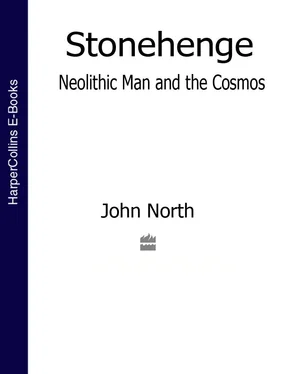standstill (lunar)A maximum or minimum of the lunar declination. (Compare the solar solstices.) This is only in the mathematical sense of there being a zero rate of change, and does not imply that there will be no greater or lesser values attained. See Appendix 2 for a fuller account of the Moon’s complex motions.
steleA standing stone or slab of modest size (say less than a metre, and often less than 30 cm) with one face only sculpted in low relief. An Anglicized Greek word. (Pronounced like the English word steel. )
tenonSee mortise.
terminalThe end of a monument (in this book usually a cursus) on the assumption that it was regarded as such by its builders and has been correctly identified.
theodoliteA portable surveying instrument, usually now mounted on a tripod and fitted with a telescope, with graduated circular scales with which angles of azimuthand altitudecan be accurately measured.
transeptA side compartment in a passage tomb, often doubled to form a plan in the form of a cross, or even quadrupled.
trapeziumA plane quadrilateral (a closed figure with four straight sides) that is not a parallelogram. Some use the word in a more special sense, adding the condition that just one pair of opposite sides be parallel.
treehengeThe name given here to a hengewith mainly timber components (uprights, lintels, etc.).
trilithonThree stones, in the form of two uprights and a lintel across the top.
trixylonTwo massive timber uprights with a timber lintel across the top (by analogy with trilithon).
tropical yearThe time taken by the Earth to travel once round the Sun, from equinoxto equinox. Alternatively, from the point of view of an observer on the Earth, the time apparently taken by the Sun to pass once round the sphere of stars, from equinox to equinox. This is the common year, of about 365.242 days.
tumulusA term used loosely for any artificial mound, called into use especially when the precise nature of the mound is unknown.
twilightThe periods after sunset and before sunrise when the sky is partially illuminated through the scattering of sunlight. Various definitions are offered ( civil, nautical, astronomical ) according to the degree of darkening thought to be significant.
urnfieldA field of pottery urns used for burial by cremation. (Also used of the culture in which this form of burial was practised.)
vallumA wall or rampart of earth, sods, or stones, possibly palisaded.
wealdor woldA wooded tract of country. (The Weald is a name used especially of an area formerly wooded between the North and South Downs of Kent, Surrey and Sussex.)
wedge tombA very long megalithic tomb, with the covering sloping down towards the end furthest from the entrance. A common Neolithic Irish form.
Windmill Hill cultureThe name given to a culture typified by the Neolithic culture responsible for the causewayed enclosure at Windmill Hill, near Avebury.
wristguardA plate of wood, stone or metal attached to the inner side of the wrist (of the hand with which an archer holds the bow), to protect the wrist from the bowstring.
zenithThe point of the sky directly above the observer. The point to which the string of a plumb line may be regarded as directed. (More precise definitions are strictly necessary if the non-spherical form of the Earth is to be taken into account.)
zodiacThe band of sky now associated with twelve constellations through which the Sun seems to pass in its annual path. See ecliptic.
PREFACE
To the Greeks, the primary sense of cosmos was that of order, harmony, and proportion. When the word was applied to the universe as a whole it was to insist that those properties—appropriate to a well regulated state, a finely decorated vase, a formally beautiful building—belonged to the universe too. Aetius tells us that Pythagoras was the first to use the word in this sense, and Stonehenge had stood for two millennia by his time. Today, as it presumably did then, Stonehenge impresses the onlooker more for its engineering than for its cosmic qualities, but it too was in a very real sense a cosmos, a geometrically ordered monument aligned on the universe of stars, Sun and Moon, and an embodiment of the spiritual forces they represented to most of mankind.
Such a claim is easier to make than to justify. It is not easy to catch at the mind of a people who lived more than four thousand years ago, and who left no written history, but the aim of this book is to do just that. Except indirectly, its concern is not with the realities of daily life, not with social structures, habitation, subsistence, or sheer survival, but rather with types of Neolithic monument that speak for the qualities of mind of the people responsible. We may have no texts, but the relatively large scale on which so many Neolithic monuments were built, combined with the modest way in which they merged into the landscape, have together ensured that time has not quite managed to obliterate them or all of their meaning. The monuments in question might not have compared in appearance with the polished glories of Egypt and Greece, but they have hidden qualities, and when those are found, the fact that they were concealed makes them all the more surprising.
What was the motivation of those who invested so much care and energy in them? The view to be defended here is that, as well as being religious, that motivation was in a strong sense astronomical, and that in this respect, few cultures of the time can compare with it. Such a claim is neither new nor precise. What is new here is the detail with which probable observing procedures are worked out, and connected with others detectible from at least as early as the fifth millennium BC. Stonehenge is like no other monument in the world, but there are many respects in which it is mistaken to regard it as unique. To understand it we must fit it into its context, both in time and space. In time, it can be shown to have continued in a venerable tradition. In space, its context is the remarkable landscape in which it stands. The number of prehistoric monuments within two kilometres of the site is to be counted not in tens but in hundreds. What is less widely recognized is that the astronomical properties of Stonehenge, as of so many earlier Neolithic monuments, were also heavily dependent on that landscape. But not entirely. Their design depended also on the state of the heavens.
It will not of course be suggested that the monument on Salisbury Plain was an astronomical observatory, at least in the current meaning of that word. The stones were not erected as a means to investigating the heavens in a detached and abstract way. The aim was not to discover the patterns of behaviour of the Sun, Moon or stars but to embody those patterns, already known in broad outline, in a religious architecture. There are signs that such ritualized architecture had been practised in the Wessex neighbourhood and elsewhere for well over a thousand years before the first phases of building at Stonehenge. While that monument in stone surpassed all before it, in architectural subtlety as well as in grandeur, to appreciate even this point one must know something of the earthen and timber structures that went before it and consequently about half of the book is concerned with that earlier material.
Читать дальше











